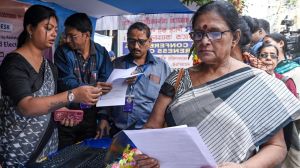Explained: Chandrayaan-2 was to be launched by India and Russia in 2011; it’s delayed but better
Chandrayaan-2 Moon landing: In fact, Chandrayaan-2 was conceived well before the launch, and success, of Chandrayaan-1.
 Chandrayaan-2 moon landing: The spacecraft was launched from Satish Dhawan Space Center at Sriharikota in Andhra Pradesh on July 22, 2019. (PTI Photo)
Chandrayaan-2 moon landing: The spacecraft was launched from Satish Dhawan Space Center at Sriharikota in Andhra Pradesh on July 22, 2019. (PTI Photo)
Chandrayaan-2 was originally scheduled to be launched way back in 2011 itself, immediately after Chandrayaan-1 which was launched in 2008 and remained functional in its orbit till about a year later. In fact, Chandrayaan-2 was conceived well before the launch, and success, of Chandrayaan-1.
At that time, however, Chandrayaan-2 was supposed to be a joint collaborative mission between India and Russia. While the Indian Space Research Organisation (ISRO) was to provide the rocket and the Orbiter module, the lander and rover modules were to come from Russia’s Roscosmos space agency. ISRO did not have the capability to build its own lander and rover at that time.
Chandrayaan-2 Moon Landing LIVE updates
The kind of lander and rover that Russia was preparing to send on Chandrayaan-2, however, developed problem on a different mission, forcing Roscosmos to make design corrections. But the new proposed design was found to be incompatible to Chandrayaan-2. Russia had to eventually pull itself out from the collaboration, which left ISRO to make efforts to develop its own lander and rover through research and development. This task took a few years to accomplish.
READ | An expert explains: ‘Seven minutes of terror’ approach. Beyond lies a new world of opportunity
This delay also provided ISRO additional time to improve on the design of the main spacecraft. The current Chandrayaan-2 composite module is a far superior design, and incorporates several additional safety features that would have not been possible in the original design that was scheduled to be launched in 2011.
- 01
- 02
- 03
- 04
- 05





































